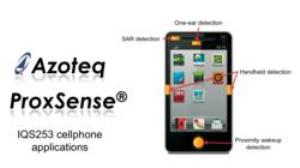Azoteq provides solutions for capacitive proximity in sliders, scroll wheels, touch screens and switches, which are used in industries. The company has introduced a new capacitive proximity sensor called IQS253. It has been recently added to Azoteq’s line of ProxSense capacitive touch and proximity controllers.
 IQS253
IQS253
IQS253 is a three-channel input device with projected (mutual) capacitance and self capacitance in a single device. Superior analog and digital circuit for better touch and proximity performance has been used in IQS253. The high-sensitivity IQS253 can function consistently through glass of 25 mm thickness and with the use of practical electrodes, it can acquire proximity detection of about 250 mm.
IQS253 contains 12C interface, which permits total control of the host microcontroller. The device consumes a low power of 6µA since it functions at a voltage of 1.8 to 3.6V. It has multiple low power modes, huge proximity detection range, automated tuning to optimal sensitivity, distributed proximity channel created by multiple keys, internal voltage regulator and reference capacitor, MSOP-10 and DFN (3x3)-10 and automated drift compensation. Azoteq’s patented DYCAL algorithm is included in IQS253, which monitors the ecological changes during extended activation.
Jean Viljoen, Marketing Manager for Asia, stated that the company’s sensors have been broadly used in tablet PCs for meeting the FCC SAR necessities and can be applied for proximity wake up in mobile phones and tablet PCs, handheld and on ear detection.
IQS253 can be used in tablet PCs, smart phones, televisions, set top boxes, Blu Ray players, remote controls, white goods and appliances, office equipments, sanitary wares and toys. It can also be used for GUI trigger and control proximity discovery and can be substituted for electromechanical levers.
The company is expected to introduce the total family of ProxSense technology by the middle of this year.